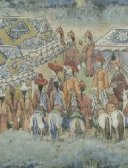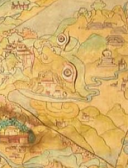མི་སྣ།
.jpg?w=128&h=168)
བུད་མེད། (104)
The historical record often bypasses mentions of women entirely or mention them only in passing when a son was born. Yet there are fascinating life stories of female religious practitioners, teachers and rulers whose influence was profound within their communities and beyond. The Treasury strives...

གཏེར་སྟོན། (68)
Treasure Revealers (gter ston) are men and women who have produced scripture or objects known as treasure (gter ma) through visionary experience, memory, or physical extraction. Generally these treasures are said to have been concealed by an earlier historical figure, with the...

ལོ་ཙཱ་བ། (96)
The category of Translators includes any historical person who engaged in the translation of texts. Generally, these figures are credited with having worked from an Indic language such as Sanskrit or Bengali source materials and translated into Tibetan. There are examples of translators who worked...

རྒྱལ་རིགས། (58)
The Treasury of Lives defines royalty as members of families that controlled empires and kingdoms as well as principalities, and specifically as individuals who are identified by titles such as king, queen, prince and so forth.

ནང་མི་དྲག་ཅན། (10)
This category comprises families that do not belong either to Tibetan royalties or Lhasa aristocracy but were nonetheless extremely prominent in Tibet, whether in trade and commerce or politics or religion.

སྐུ་དྲག་ནང་མི། (50)
The category of Lhasa aristocracy on the Treasury of Lives encompasses the elite families of the Ganden Podrang government.

། (24)
In the category of Indian Masters we include all men and women from Bengal, Kashmir, the Ganges Plain, and other regions of the subcontinent that Tibetans considered "India."

སྐུ་རབས། (121)
The Treasury of Lives tracks all incarnation lines when we have a biography of at least one member. Each line has a dedicated page with a brief description, a timeline, and a list of members with biographies. To the best of our ability we enumerate incarnations according to the tradition's own...

གཞུང་ཞབས། (36)
On the Treasury of Lives a government official is considered any person who served, in an official capacity, in a national or regional government office. This includes those who were born into the position, in the case of an aristocrat. In the Himalayan or Mongolian context a government official might be either lay or cleric.

སྨན་པ། (40)
The category of doctors in the Treasury of Lives includes individuals who received medical training and practiced the healing arts, in a fashion appropriate for their time, and who self-identified or are described in the historical literature as medical practitioners.

རིགས། (278)
Traditional classifications of clans in Tibet generally name four or six ancestral clans who are believed to descend from the progeny of the Bodhisattva monkey and demoness, the subjects of Tibet's origin myth. These lineages later split into numerous sub-clans that are often associated with specific geographical regions, and in some cases, monasteries.

སྒྱུ་རྩལ་པ། (16)
The category of Artist includes biographies of people who were engaged in the production of visual art, either as their primary activity or in addition to other other social roles they held. This includes religious art as well as secular art, both painting and sculpture.

ཁྲི་པ། (193)
The category of abbots comprises the heads of all the monasteries and associated colleges. The abbacy is a position that usually comes with seniority and accomplishment, and abbots generally possess Geshe degrees or the highest equivalent in their tradition. Tripa, Tridzin, Khenpo, Khenchen are...